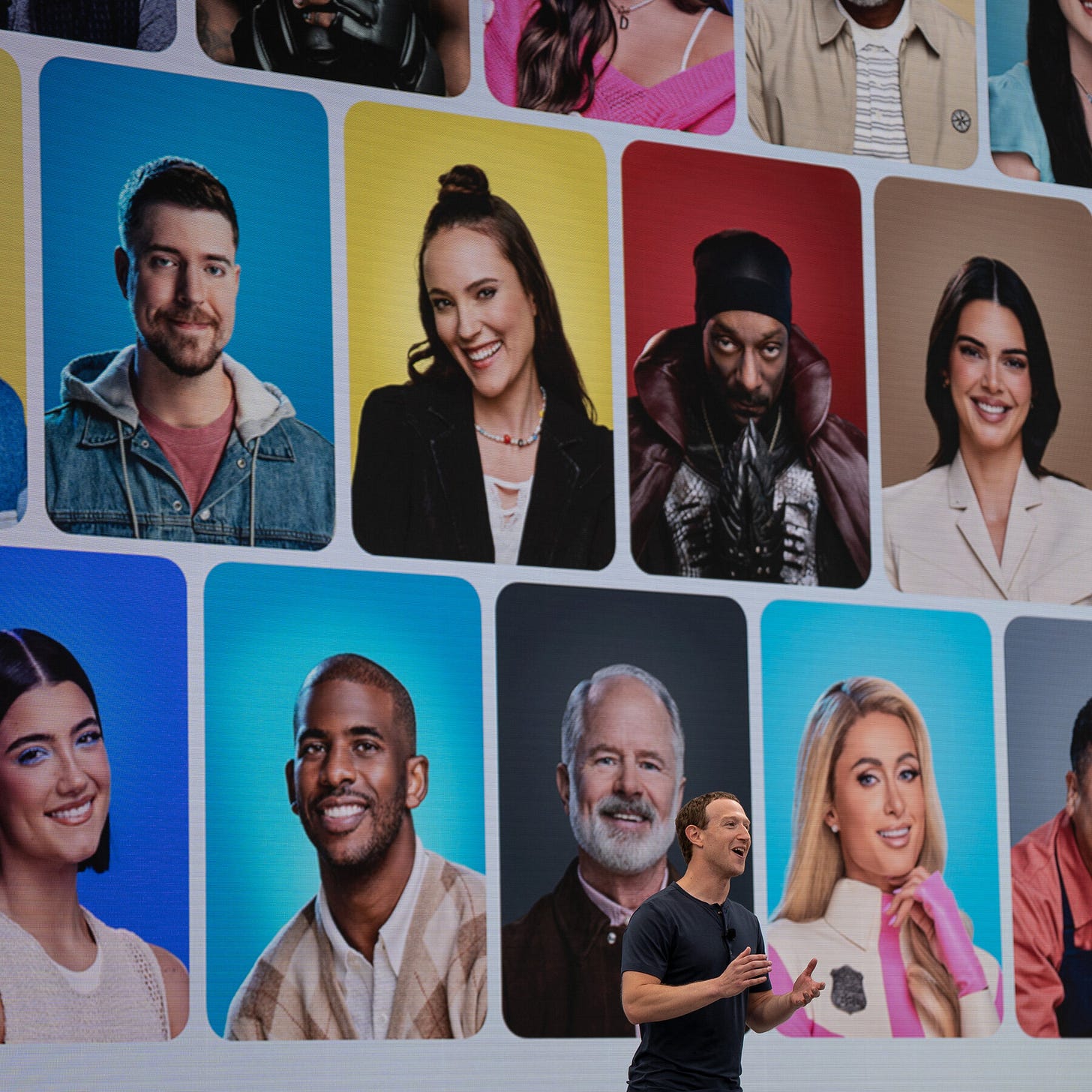After months of hints and anticipation, today Meta Founder/CEO Mark Zuckerberg unveiled Meta’s ‘Smart Agent’ AIs, along with other new products and services at the company’s Connect Developer Conference. Key difference vs OpenAI, Google and other LLM AIs that Meta was focusing on according to Mr. Zuckerberg,
“People aren’t going to want to interact with one single super intelligent A.I. — people will want to interact with a bunch of different ones.”
He went onto add:
“Most people haven’t had the chance to experience the newest and most powerful A.I technologies. That’s a thing that I think we can change.”
So no one-size-fits-all approach for Meta and its billions of daily users worldwide. There’s a different ambition here vs their peers:
“Now Meta is using its tried-and-true playbook of leveraging its enormous size — globally, more than three billion people use its products — to popularize its offerings. And whereas interactions with ChatGPT and Google’s Bard chatbot have largely been between an individual and the bot or within productivity programs like Gmail, Mr. Zuckerberg envisions users of Instagram, Facebook and WhatsApp interacting with chatbots more socially in their everyday conversations and group chats with friends.”
The NY Times piece above goes onto to give a range of examples of these interactions. But Meta’s approach expands on multi-personality ‘smart agent’ AIs being tried by others:
“Other social networking apps have also started weaving in A.I. abilities. Snap added a chatbot this year to its social media service, Snapchat, which is popular among teenagers. Its chatbot is embodied by a digital avatar that users can rename and customize. And Character.AI, a Silicon Valley start-up, offers a service in which people can chat with a reasonable facsimile of almost anyone, living or dead.”
Meta seeks to expand and entertain at scale:
“Meta’s new character-like bots work similarly to Snapchat’s offering — and a little like the digital personalities offered by Character.AI.”
“One Meta A.I. character — Amber, modeled after Paris Hilton — plays a detective partner for “solving whodunits” in chats. Kendall Jenner’s character, called Billie, is described as a “No BS, ride-or-die companion.” The tennis star Naomi Osaka’s character, Tamika, is an “anime-obsessed Sailor Senshi in training,” while Snoop Dogg plays a Dungeon Master in a sendup of Dungeons and Dragons with a “choose your own adventure” type of experience.
The celebrities and athletes are being paid for their A.I. characters; Meta did not provide details on compensation.”
TechCrunch has more details on how the celebrity personalities were made into AIs.
Mr. Zuckerberg also introduced ‘Meta AI’ along with the AI personalities. As TechCrunch described it:
“Meta AI can be invoked in any chat, Meta says. And like ChatGPT, it can generate watermarked images leveraging a text-to-image model called Emu, developed by Meta’s AI research division.”
“Beyond Meta AI, Meta today introduced a range of “AI characters” — basically chatbots tuned to channel certain personalities and mimic celebrities, including Kendall Jenner, Dwyane Wade, MrBeast, Paris Hilton, Charli D’Amelio and Snoop Dogg (additional bots, including for Bear Grylls, Chloe Kim and Josh Richards, are on the way). Like Meta AI, the chatbots — which have profile images, either illustrated or real-life — live in Meta’s messaging apps. And as you chat with them, the avatars subtly animate based on the conversation.”
But it’s still early days for this technology, and a lot of wrinkles have to be ironed out. Meta also plans multimodal capabilities soon for its AI assistants, something that is a focus for all their peers as I’ve noted.
Then, there’s the issue of safety and reliability. As TechCrunch notes:
“This all sounds… interesting in theory. But very recent history has shown that even the best AI chatbots can go off the rails, making things up and generally missing key points in conversations.”
The NY Times continues (some links mine):
“The characters are a way for people to have fun, learn things, talk recipes or just pass the time — all within the context of connecting with friends and family, company executives said.”
“We see people going to different A.I.s for different things, which is how we see ourselves building out an ecosystem of many more A.I.s over time,” said Ahmad Al-Dahle, Meta’s vice president of generative A.I.”
“But like other chatbots, Meta’s chatbots can generate false and misleading information — a phenomenon that researchers call hallucination. This can happen even when the bot bases its answer on what it grabs from a search engine.”
“Mr. Al-Dahle said Meta had spent thousands of hours doing “red team” scenarios to test the potential misuse of the technologies. The company has also published a set of responsible-use guidelines for those who want to use Meta’s underlying technology to eventually power their own chatbots.”
“Many of the products will also be rolled out in a limited capacity to U.S. users only, as the company works out any early kinks and watches how users respond.”
As I’ve highlighted before, Meta is also taking a different approach than its peers with its focus on providing open source LLM AI models and developer software tools like PyTorch. And that may help them take this direction in broader and deeper directions faster than their peers:
“A future with legions of chatbots could be closer than we might think. Meta’s public release in July of LLaMA 2 — the code behind its latest and most advanced A.I. technology — was enthusiastically greeted by developers and has been downloaded more than 30 million times.” “
Meta is working with Microsoft, Google and Amazon’s cloud services divisions to host the technology for developers who want to create the next generation of bots that can do whatever the coders want them to do — for better or worse.”
And Meta is also leveraging its core properties for additional ways to train next generation LLM AI at scale. Much like Google is using YouTube, as I’ve highlighted before. This Washington Post titled: “Your Instagrams are training AI. There’s Little you can do about it”:
“The new Meta AI chatbot and image generators are just the latest examples of how Big Tech is taking your conversations, photos or documents to teach their AI.”
“They’re your Instagram and Facebook posts. They’re also Meta’s artificial intelligence factory.”
On Wednesday, the social media giant unveiled a Meta AI chatbot and image-generators that can re-imagine just about anything. Its source material: images and text from our public posts. It didn’t ask permission.”
“Your wedding dress, your baby pictures, your … dad bod could all now be applied to someone else.”
As I’ve mentioned before, ‘extractive data’ is the big holy grail for all the AI companies, given that LLM AI models need ever-growing pools of Data train to run their training and inference reinforcement learning loops on in this AI Tech Wave. Therefore,
“Meta is not alone. Unless you turn it off, Google uses your Gmail to train an AI tofinish other people’s sentences. It does that by analyzing how you respond to its suggestions. And when you opt in to using a new Gmail function called Help Me Write, Google uses what you type into it to improve its AI writing, too. You can’t say no.”
“Microsoft uses your chats with Bing to coach the AI bot to better answer questions, and you can’t stop it.”
“Increasingly, tech companies are taking your conversations, photos and documents to teach their AI how to write, paint and pretend to be human. You might be accustomed to them selling your data or using it to target you with ads. But now they’re using it to create lucrative new technologies that could upend the economy — and make Big Tech even bigger.”
We are in a period of early experimentation at scale, and a lot of spaghetti will be thrown against the wall. Let’s see what sticks. It’s going to be messy, but what remains may be delicious. Stay tuned.
(NOTE: The discussions here are for information purposes only, and not meant as investment advice at any time. Thanks for joining us here)











